Process art is such an important part of any preschool program, no matter the child’s age. Big scribbling is a really simple, but effective, process art activity for toddlers. But more importantly, big scribble art for toddlers, like this activity, encourages the development of important stages in emergent writing.
How Scribbling Develops Emergent Writing Skills
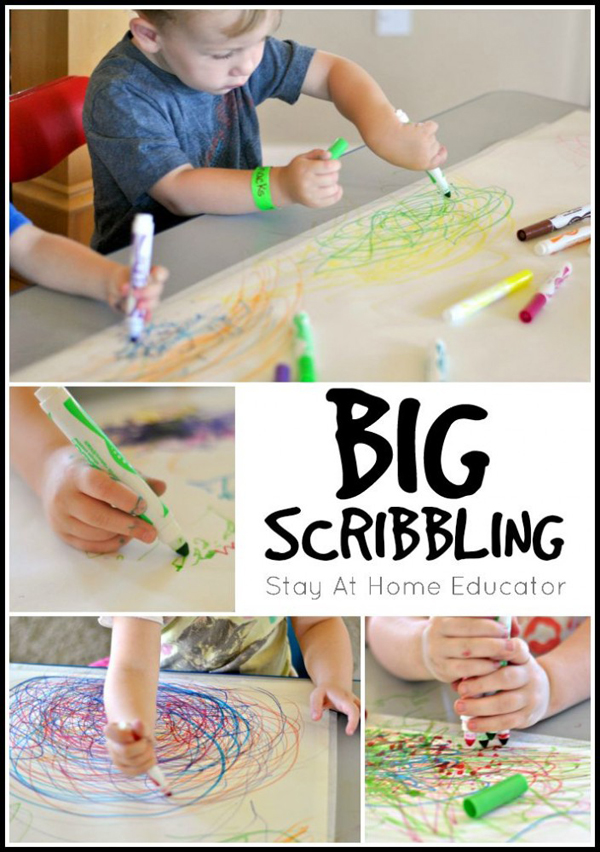
In my toddler preschool program we try to do a little process art everyday, but it isn’t always extravagant and fridge worthy. In fact, 90% of the time I don’t even write about the art activity here on the site. Process art truly is about the process.
And so is big scribbling. But big scribbling is also an important stage in emergent writing, which is why scribbling activities for toddlers should be added to your lesson plans.
The scribbling stage in important, and should be encouraged, not skipped. Because to toddlers and young preschoolers, scribbling has meaning and teaches the beginning fundamentals of writing.
-
Product on sale
 Prewriting Cards for the Entire YearOriginal price was: $16.00.$8.00Current price is: $8.00.
Prewriting Cards for the Entire YearOriginal price was: $16.00.$8.00Current price is: $8.00.
FAQ About Emergent Writing in Preschool
Emergent writing is when a young child first attempts to write. This is when they start by drawing pictures and making marks on paper.
Sometimes these random scribbling and symbols stand for their thoughts and ideas. Other times they are just experimental.
As children keep learning, they will go through different, yet predictable, stages of writing.
Every child approaches writing differently and some will spend less time than others in the initial stages of writing. The stages of emergent writing are: writing that consists of drawing or scribbling, writing letter-like symbols, use of letters, use of letters and spaces, conventional spelling and writing.
Scribbling looks random, uncontrolled markings, but to a child scribbles are very purposeful. While scribbles do not resemble letters or writing, they do represent the ideas of a young writer.
It is beneficial for children to draw and scribble because it feels like a comfortable starting point for their ideas and allows them to participate in the writing process. These beginning attempts at writing can be proud accomplishments to a youngster and should be encouraged.
Easy Art Lesson Plans for Toddlers
By using simple items from around the house, we turn everyday moments into exciting adventures. Starting art early plays a big role in helping kids learn to express themselves, think outside the box, and play well with others.
So, it’s not just about making art—it’s about setting the foundation for growing up in all sorts of wonderful ways.
Try out our weekly art lesson plans for preschoolers!
-
Product on sale
 Prewriting Cards for the Entire YearOriginal price was: $16.00.$8.00Current price is: $8.00.
Prewriting Cards for the Entire YearOriginal price was: $16.00.$8.00Current price is: $8.00. -
 Editable Name Spelling Practice Mats$6.00
Editable Name Spelling Practice Mats$6.00
Big Scribbling Activity for Toddlers and Emergent Writers
This activity ends up being both process art for toddlers and en emergent writing activity that focusing on the scribbling stage in writing.
It is an opportunity for the children to explore a set of materials. In an activity like big scribbling, my job as the preschool teacher is more to sit back and observe, encourage and ask questions. I do not give directions or require the children to use the materials in a specific way, (as long as they are being safe and not damaging the materials).
In this post I share how my 2-3’s preschool class explored the most basic set of materials: paper and markers.
Materials
- large sheets of paper, such as that from a roll of craft paper
- markers or crayons (non-toxic, please)
- making tape (optional)
The Set Up
Roll out a long sheet of paper so that is covers the entire table, if possible. Tape it down so it does not move. Toddlers like to lean into their drawings, so having the paper taped to the table kept it from moving as they drew, and also kept the edges from folding over.
Set out a set of colorful makers or crayons and invite your toddler to color or draw.
The Big Scribbling Activity for Toddlers
When offered handfuls of color markers and what seems like an unlimited supply of paper, toddlers won’t hesitate to being drawing. They made their color choices and got to work.
The scribbling started out as large and vigorous. Some children colored in circles as big and as fast as their bodies were capable. Gradually, the scribbling slowed down and became more purposeful.
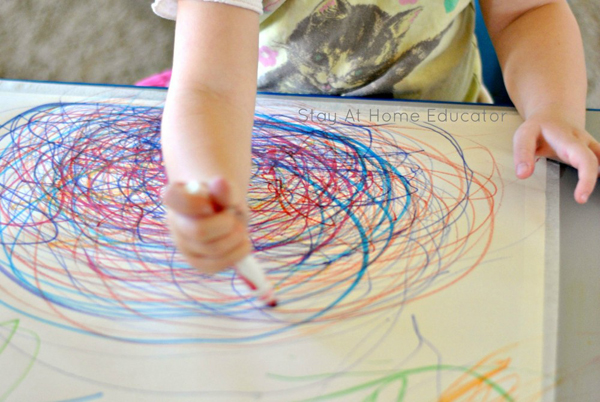
Young children in the scribbling stage will explore high-spirited and wild scribbling and then transition to controlled scribbling. Typically, we think of scribbling as being large circular like drawings, but scribbling can also be quick and hard vertical lines, or jagged zig zags.
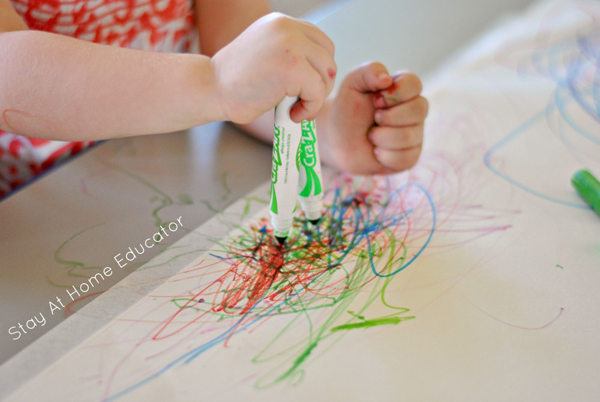
The toddlers tried drawing with more than one marker at once, and they used both hands. They makes dots and stippled into their drawings. Exploring writing utensils is part of child development in early writing, so don’t be surprised when you see a toddler fist an entire pack of markers. They might attempt this as early as 18 months.

The children also experimented with holding the markers in different ways. Some pretended to write words by carefully holding their markers in the most mature pencil grasp their fine motor skills could manage. All this experimenting helps the children process the various aspects of writing.
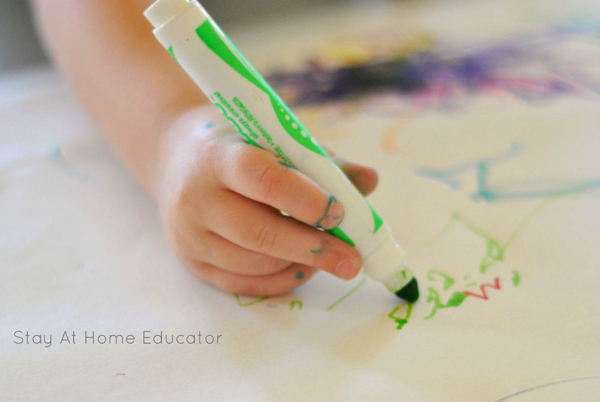
Some of the toddlers even tried to write their names. While most are still unaware of the letter strings and letter sounds that make up their names, when I went around to place an initial for the child’s name at the top of their paper, they made smaller marks alongside it. The toddler above made some very clear marks in an attempt to write her name. “Look, I write Mila!” she exclaims.
Related
How to Add More Writing Activities to Preschool
Children develop are different rates, and that also means they will progress through the emergent writing stages at different rates. Having a preschool writing center with loads of different kinds of fine motor activities and writing supplies will benefit the children.
Try some of these ideas in your writing center.
- different writing utensils like markers, crayons, rock crayons, golf pencils, dot markers, etc.
- different sizes and types of paper, including lined paper, printer paper, and construction paper
- stickers to make stories or practice peeling, which is a fine motor skill
- stamps, like letter stamps
- tracing sheets, including letter tracing worksheets and prewriting lines
- examples of writing, like lists, alphabet letters, names, and drawings that show basic lines
- examples of what the child writes
Get Writing Printables Here
-
Product on sale
 Prewriting Cards for the Entire YearOriginal price was: $16.00.$8.00Current price is: $8.00.
Prewriting Cards for the Entire YearOriginal price was: $16.00.$8.00Current price is: $8.00. -
 Editable Name Spelling Practice Mats$6.00
Editable Name Spelling Practice Mats$6.00 -
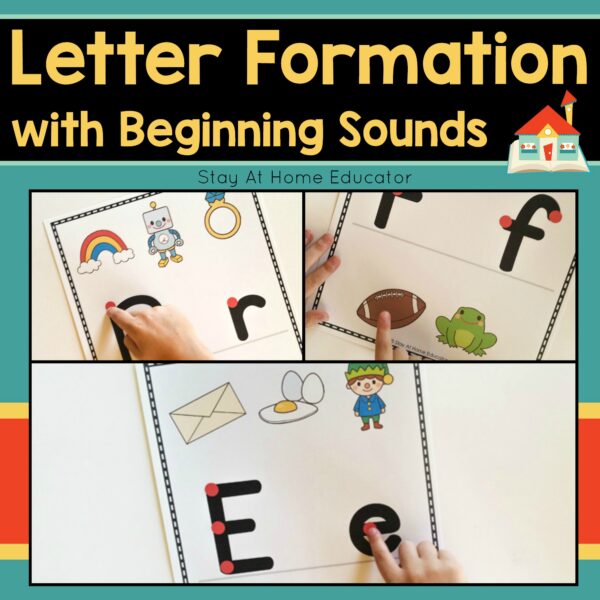 Letter Formation Mats with Beginning Sounds$5.00
Letter Formation Mats with Beginning Sounds$5.00 -
 Fine Motor Letter Formation Practice Mats$4.00
Fine Motor Letter Formation Practice Mats$4.00
Related Emergent Writing Articles
You might also be interested in these articles about the stages of emergent writing and also pencil grasp development.

I’m Sarah, an educator turned stay-at-home-mama of five! I’m the owner and creator of Stay At Home Educator, a website about intentional teaching and purposeful learning in the early childhood years. I’ve taught a range of levels, from preschool to college and a little bit of everything in between. Right now my focus is teaching my children and running a preschool from my home. Credentials include: Bachelors in Art, Masters in Curriculum and Instruction.

[…] will resist tracing until they have fairly developed fine motor skills. (They will still be interested in scribbling and drawing, at this stage, just not so much interest in […]